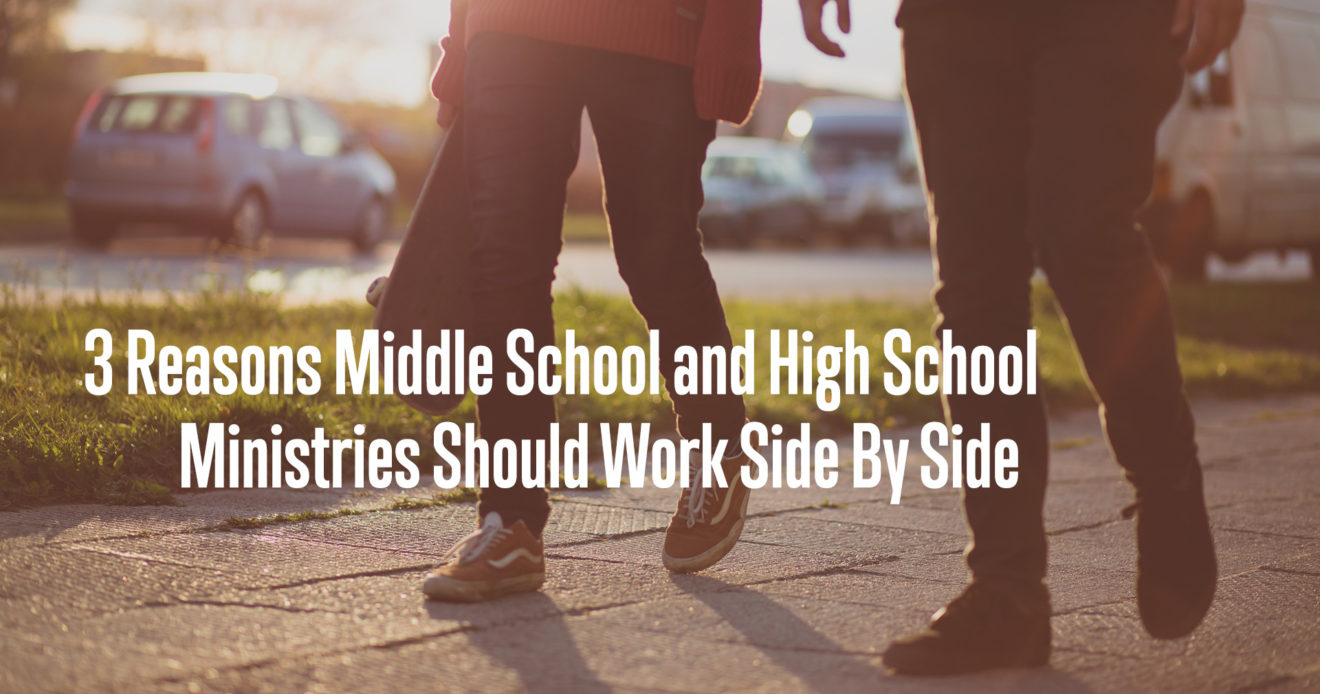
3 Reasons Middle School and High School Ministries Should Work Side By Side
Can high school ministry and middle school ministry work together? Is it possible that students straight out of elementary school could work alongside college-bound seniors? Not only is this possible, but incredibly beneficial to your ministry. In fact, I would even argue that for a successful ministry, it is a must.
It is a benefit not only to the ministry but the church body as a whole. Let me show you what I mean.
The younger look up to the older.
Believe it or not, your middle school students are watching your high school students and trying to figure out what kind of high school student they want to be. Younger students always look up to the older students. Intentional or not, your high school students are setting an example to the younger students. Good, bad, or ugly. Therefore, life-on-life or some kind of peer mentoring is a must.
But please don’t create another program or initiative. Don’t announce to your high school students that you are creating a mentoring program. I have no doubt you will get eye rolls and risk a sudden drop in attendance. Don’t just preach it from the pulpit and cut them loose hoping that somehow mentoring happens. However, do be intentional and purposeful. Provide the space and opportunity for mentoring to occur naturally.
Teach students mentoring skills and coach them regularly. Have you ever heard of a basketball coach having his players sit in chairs and listen to a lecture on the mechanics of shooting; and then tell them to go home and practice? We all want our students to be disciples and to be disciple-makers. But rather than preaching the mechanics of making disciples from the stage, give students the opportunity to practice while you are there. A great coach demonstrates the skill first and then allows players to practice, make mistakes, and corrections on the spot. The same goes for mentoring. And guess what? This gives you the chance to mentor your student mentors.
Practically speaking, your high school students could do something as simple as help with games (you could even have a group grab the Awana game book and plan the games), be small group leaders, lead worship, or even teach a lesson. Pick what works best not only for your group but also what matches your high school students’ desires and gifts. Stretch them, don’t cripple them. Prepare them, coach them, correct when necessary, praise when appropriate.
One of the biggest mistakes I see is when youth leaders cut high school students loose unprepared and unchecked. And then we wonder why our efforts didn’t work. Have them review the Trek leader guides, leader videos, and help them plan small group time.
Teachers are better learners.
A few nights ago, my family was out for dinner. As we sat down, my wife I and organized the kid's coats and gave them each their kid’s menus. As each of them was in deep concentration on their task, I had the joy of witnessing something beautiful between my youngest and oldest daughters. My eight-year-old began teaching my three-year-old how to play tic-tac-toe. She patiently described the goal and the strategy. She even let her little sister win a few games to gain some confidence and lose a few to see what she was doing wrong.
One of the most effective teaching strategies is to have students teach. Teachers use it all the time in the classroom. Why not utilize this inside your youth group. Why is it so effective? It does more than just teach your high school students a concept or two. It creates a deeper appreciation for the concept they are teaching and solidifies what they are learning. When students dig into the material, they will “get it” at a more meaningful level. It also fosters a greater and more significant relationship between the younger and older students. Students who engage in teaching others become invested in their learning. High school students will want to see that their efforts have helped in some way. It creates ownership.
What does this look like practically? Take a look at the core concepts throughout the Journey: Disciples curriculum. Each of them is laser focused on helping students live the life of a disciple. To live and love like Jesus. One of the most practical ways to live out what they are learning is to serve the younger students. At the same time, your middle school students could be witnessing older students striving to be like the God they are learning so much about. They would be seeing in action older students living out their story in God's grand narrative.
Then you will start to see some really cool things happen.
You are creating a culture and tradition of serving one another
Several years ago, I taught at a small Christian school. One that was small enough that middle school and high school existed in the same building with a few spaces of overlap; yet big enough that each had their separate hallways and classrooms. During my time as the director of spiritual life, we were trying to find ways prepare the incoming freshman classes better. Discipleship was lacking, and student leadership in the middle school was non-existent. So we took a small group of student leaders in the high school and had them begin mentoring the middle school students. We started small, but we began with the two things I listed above—mentoring, and using the older students to teach the younger whenever possible.
There was no doubt that middle school students were being mentored and the high school students saw a greater value in the younger students and consequently became better disciples. Ultimately that was our goal, and we accomplished it. But something else started to happen as we continued to work intentionally with these ideas and increase participation among students.
The culture of the school began to change.
Let’s face it. Many of our high school students view middle school students as irritating. Even implementing mentoring programs can come off as forced and obligatory. But we pressed forward. Eventually, the older students began to see the younger students differently. They became invested, committed, and finally, we saw active engagement with the middle school without any prompting. They served each other and cared for each other.
Even more, than that, the high school students began to see the value of mentorship and so they sought after mentors for themselves. Of course, there is still coaching to be done, corrections to be made, and opportunities to learn. But when we create the space for mentoring to happen, you are planting seeds for a culture of service to one another to grow. And it will…exponentially.
Whether books or blog posts, there is an awful lot of discussion about the power of intergenerational ministry. But as a youth worker, the chance for an older group to mentor a younger has been dropped in your lap. Don’t miss it, leverage it.
Get more information on how Trek for middle school and Journey for high school can help you create a natural blend between middle school and high school.
Steve Kozak
Executive Director of AwanaYM
Steve currently serves as the Executive Director of AwanaYM. Previously, Steve spent over a decade teaching high school theology and apologetics from Detroit to LA. Steve holds a Masters degree in Theology from Moody Theological Seminary and a Masters in Christian Apologetics from Biola University. Steve is also an adjunct professor at Trinity International University. He speaks and writes on youth ministry, youth culture and apologetics. He resides in Chicago, IL with his wife and four children.FollowSteve Kozak on Twitter: stevenmkozak
Comments
Get the AwanaYM Update
Receive youth ministry resources in your inbox. Subscribe today!
